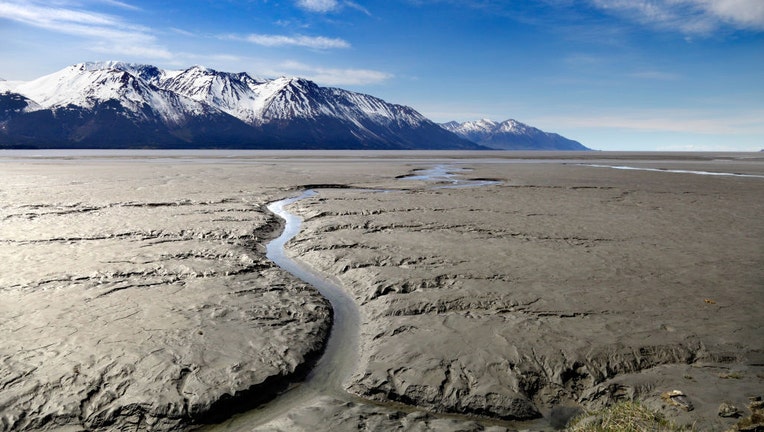Man drowns after getting stuck in waist-deep mud flats in Alaska

A view of Turnagain Arm mud flats from on board the Anchorage to Seward Express in Alaska. (Planet One Images/Universal Images Group via Getty Images)
ANCHORAGE, Alaska - A man who was walking on tidal mud flats with friends in an Alaska estuary got stuck up to his waist in the quicksand-like silt and drowned as the tide came in before frantic rescuers could extract him, authorities said.
Zachary Porter, 20, of Lake Bluff, Illinois, was submerged Sunday evening as the tide came in, and his body was recovered Monday morning, Alaska State Troopers spokesperson Austin McDaniel told The Associated Press.
A member of Porter's group called 911 when they couldn't get him out, but it was too late, authorities said.
RELATED: One killed after building collapses in Alaska
The accident was the latest tragedy at Turnagain Arm, a 48-mile-long (77-kilometer-long) estuary carved out long ago by glaciers that travels southeast from the Anchorage area and parallels a major highway.
At low tide, the estuary is known for its dangerous mud flats made of silt created by glacier-pulverized rocks. At least three other people have gotten stuck and drowned there over the years. Many more have been rescued, including someone who was fishing there last month.
"It’s big, it’s amazing, it’s beautiful, and it’s overwhelming," Kristy Peterson, the administrator and lead EMT for the Hope-Sunrise Volunteer Fire Department, said of Alaska. "But you have to remember that it’s Mother Nature, and she has no mercy for humanity."
RELATED: Fallen climber rescued at Alaska’s Denali National Park
Peterson, who responded to the call, spoke with others in Porter's party but didn’t talk to him during the desperate rescue attempt.
"When we respond, we respond with the utmost of good intentions and as mothers and fathers and uncles and brothers," she said. "We respond with as much passion and vigor as we can."
The volunteer members of the department will gather later in the week for a debriefing, she said.
"I have been in contact with all my members, and they’re all heartbroken," Peterson said. "This is a hard situation."
RELATED: Polar bear kills mother, son in Alaska village, state troopers say
The accident occurred near the community of Hope, a quaint community of about 80 people. It lies across Turnagain Arm just 22 miles — but a 90-minute drive — from Anchorage.
The estuary travels southeast from the Anchorage area and parallels the Seward Highway, the only highway that goes south and delivers tourists from Anchorage to the sportsman’s paradise of the Kenai Peninsula.
At low tide, Turnagain Arm is known for its mud flats that "can suck you down," Peterson said. "It looks like it’s solid, but it’s not."
When the tide comes back in, the silt gets wet from the bottom, loosens up and can create a vacuum if a person walks on it.
Signs are posted warning people of hazardous waters and mud flats.
"I’ve really got to warn people against playing the mud," Peterson said. "It’s dangerous."
Some people attempt to walk across Turnagain Arm or walk the 9 miles (14 kilometers) from Anchorage to Fire Island during low tide, sometimes prompting rescue efforts.
There have been other deaths on the mud flats. In 1988, newlyweds Adeana and Jay Dickison were gold dredging on the eastern end of the arm when her ATV got stuck in the mud, the Anchorage Daily News reported. She then became stuck when trying to push it out and drowned with the incoming tide.
In 1978, an unnamed Air Force sergeant attempting to cross Turnagain Arm was swept away with the leading edge of the tide. His body was never found, the Anchorage newspaper reported. In 2013, Army Capt. Joseph Eros died while trying to cross from Fire Island back to Anchorage.
Earlier this month, a man was rescued from the mud flats after one leg became stuck, and he sank to his waist while fishing in Turnagain Arm.
Peterson said they got the rescue call after Porter was in serious trouble, and it takes time to mobilize. Another department — about an hour’s drive away — also responded.
Peterson urged people to call 911 as soon as possible.
"If you think that there’s an issue, if you think that there even might be an issue, call," she said. "Because we can get resources moving, and we would rather turn around and go home then it would be a disaster."

